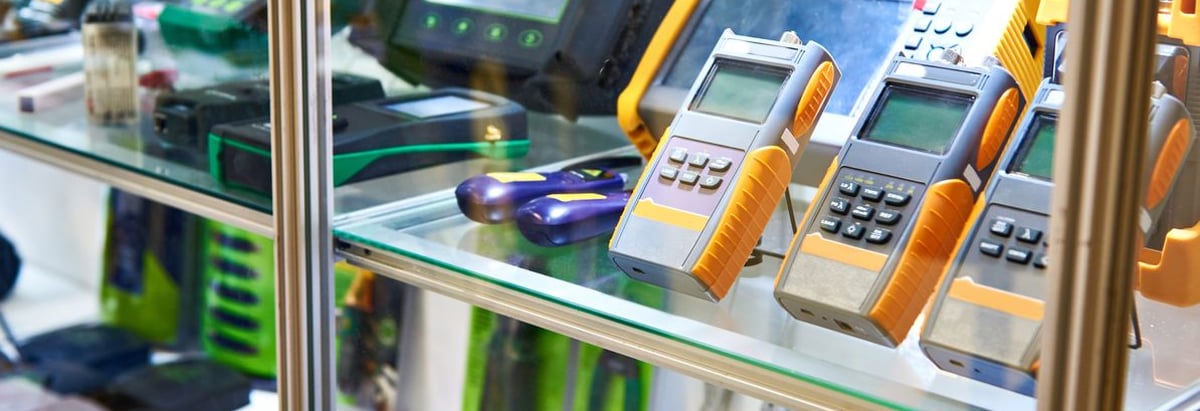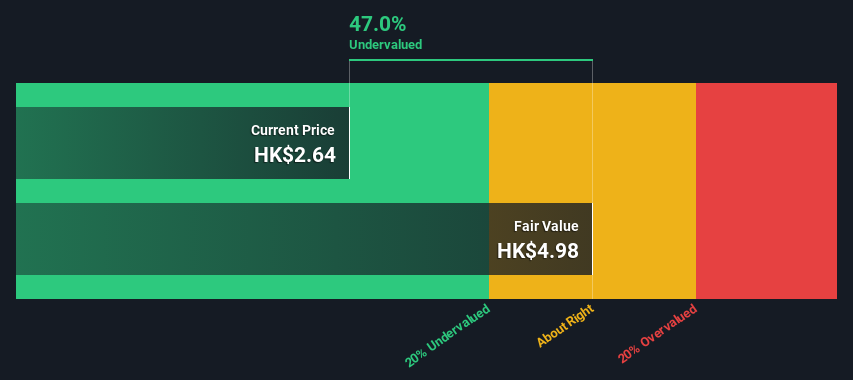- Hong Kong
- /
- Electronic Equipment and Components
- /
- SEHK:3969
An Intrinsic Calculation For China Railway Signal & Communication Corporation Limited (HKG:3969) Suggests It's 47% Undervalued

Key Insights
- The projected fair value for China Railway Signal & Communication is HK$4.98 based on 2 Stage Free Cash Flow to Equity
- China Railway Signal & Communication's HK$2.64 share price signals that it might be 47% undervalued
- The CN¥4.08 analyst price target for 3969 is 18% less than our estimate of fair value
Does the February share price for China Railway Signal & Communication Corporation Limited (HKG:3969) reflect what it's really worth? Today, we will estimate the stock's intrinsic value by taking the expected future cash flows and discounting them to their present value. The Discounted Cash Flow (DCF) model is the tool we will apply to do this. It may sound complicated, but actually it is quite simple!
We generally believe that a company's value is the present value of all of the cash it will generate in the future. However, a DCF is just one valuation metric among many, and it is not without flaws. Anyone interested in learning a bit more about intrinsic value should have a read of the Simply Wall St analysis model.
See our latest analysis for China Railway Signal & Communication
The Model
We're using the 2-stage growth model, which simply means we take in account two stages of company's growth. In the initial period the company may have a higher growth rate and the second stage is usually assumed to have a stable growth rate. In the first stage we need to estimate the cash flows to the business over the next ten years. Where possible we use analyst estimates, but when these aren't available we extrapolate the previous free cash flow (FCF) from the last estimate or reported value. We assume companies with shrinking free cash flow will slow their rate of shrinkage, and that companies with growing free cash flow will see their growth rate slow, over this period. We do this to reflect that growth tends to slow more in the early years than it does in later years.
Generally we assume that a dollar today is more valuable than a dollar in the future, so we discount the value of these future cash flows to their estimated value in today's dollars:
10-year free cash flow (FCF) estimate
| 2024 | 2025 | 2026 | 2027 | 2028 | 2029 | 2030 | 2031 | 2032 | 2033 | |
| Levered FCF (CN¥, Millions) | CN¥2.17b | CN¥2.54b | CN¥2.86b | CN¥3.13b | CN¥3.35b | CN¥3.54b | CN¥3.70b | CN¥3.84b | CN¥3.96b | CN¥4.08b |
| Growth Rate Estimate Source | Analyst x1 | Est @ 16.94% | Est @ 12.47% | Est @ 9.34% | Est @ 7.15% | Est @ 5.62% | Est @ 4.54% | Est @ 3.79% | Est @ 3.27% | Est @ 2.90% |
| Present Value (CN¥, Millions) Discounted @ 8.6% | CN¥2.0k | CN¥2.2k | CN¥2.2k | CN¥2.2k | CN¥2.2k | CN¥2.2k | CN¥2.1k | CN¥2.0k | CN¥1.9k | CN¥1.8k |
("Est" = FCF growth rate estimated by Simply Wall St)
Present Value of 10-year Cash Flow (PVCF) = CN¥21b
We now need to calculate the Terminal Value, which accounts for all the future cash flows after this ten year period. The Gordon Growth formula is used to calculate Terminal Value at a future annual growth rate equal to the 5-year average of the 10-year government bond yield of 2.0%. We discount the terminal cash flows to today's value at a cost of equity of 8.6%.
Terminal Value (TV)= FCF2033 × (1 + g) ÷ (r – g) = CN¥4.1b× (1 + 2.0%) ÷ (8.6%– 2.0%) = CN¥63b
Present Value of Terminal Value (PVTV)= TV / (1 + r)10= CN¥63b÷ ( 1 + 8.6%)10= CN¥28b
The total value, or equity value, is then the sum of the present value of the future cash flows, which in this case is CN¥49b. In the final step we divide the equity value by the number of shares outstanding. Relative to the current share price of HK$2.6, the company appears quite good value at a 47% discount to where the stock price trades currently. Remember though, that this is just an approximate valuation, and like any complex formula - garbage in, garbage out.

Important Assumptions
The calculation above is very dependent on two assumptions. The first is the discount rate and the other is the cash flows. If you don't agree with these result, have a go at the calculation yourself and play with the assumptions. The DCF also does not consider the possible cyclicality of an industry, or a company's future capital requirements, so it does not give a full picture of a company's potential performance. Given that we are looking at China Railway Signal & Communication as potential shareholders, the cost of equity is used as the discount rate, rather than the cost of capital (or weighted average cost of capital, WACC) which accounts for debt. In this calculation we've used 8.6%, which is based on a levered beta of 1.166. Beta is a measure of a stock's volatility, compared to the market as a whole. We get our beta from the industry average beta of globally comparable companies, with an imposed limit between 0.8 and 2.0, which is a reasonable range for a stable business.
SWOT Analysis for China Railway Signal & Communication
- Earnings growth over the past year exceeded the industry.
- Debt is not viewed as a risk.
- Dividend is low compared to the top 25% of dividend payers in the Electronic market.
- Annual revenue is forecast to grow faster than the Hong Kong market.
- Good value based on P/E ratio and estimated fair value.
- Dividends are not covered by cash flow.
- Annual earnings are forecast to grow slower than the Hong Kong market.
Moving On:
Valuation is only one side of the coin in terms of building your investment thesis, and it ideally won't be the sole piece of analysis you scrutinize for a company. The DCF model is not a perfect stock valuation tool. Instead the best use for a DCF model is to test certain assumptions and theories to see if they would lead to the company being undervalued or overvalued. If a company grows at a different rate, or if its cost of equity or risk free rate changes sharply, the output can look very different. Why is the intrinsic value higher than the current share price? For China Railway Signal & Communication, there are three important items you should explore:
- Risks: Take risks, for example - China Railway Signal & Communication has 1 warning sign we think you should be aware of.
- Future Earnings: How does 3969's growth rate compare to its peers and the wider market? Dig deeper into the analyst consensus number for the upcoming years by interacting with our free analyst growth expectation chart.
- Other High Quality Alternatives: Do you like a good all-rounder? Explore our interactive list of high quality stocks to get an idea of what else is out there you may be missing!
PS. Simply Wall St updates its DCF calculation for every Hong Kong stock every day, so if you want to find the intrinsic value of any other stock just search here.
New: AI Stock Screener & Alerts
Our new AI Stock Screener scans the market every day to uncover opportunities.
• Dividend Powerhouses (3%+ Yield)
• Undervalued Small Caps with Insider Buying
• High growth Tech and AI Companies
Or build your own from over 50 metrics.
Have feedback on this article? Concerned about the content? Get in touch with us directly. Alternatively, email editorial-team (at) simplywallst.com.
This article by Simply Wall St is general in nature. We provide commentary based on historical data and analyst forecasts only using an unbiased methodology and our articles are not intended to be financial advice. It does not constitute a recommendation to buy or sell any stock, and does not take account of your objectives, or your financial situation. We aim to bring you long-term focused analysis driven by fundamental data. Note that our analysis may not factor in the latest price-sensitive company announcements or qualitative material. Simply Wall St has no position in any stocks mentioned.
About SEHK:3969
China Railway Signal & Communication
Provides rail transportation control system solutions in China and internationally.
Excellent balance sheet and fair value.
Similar Companies
Market Insights
Community Narratives



